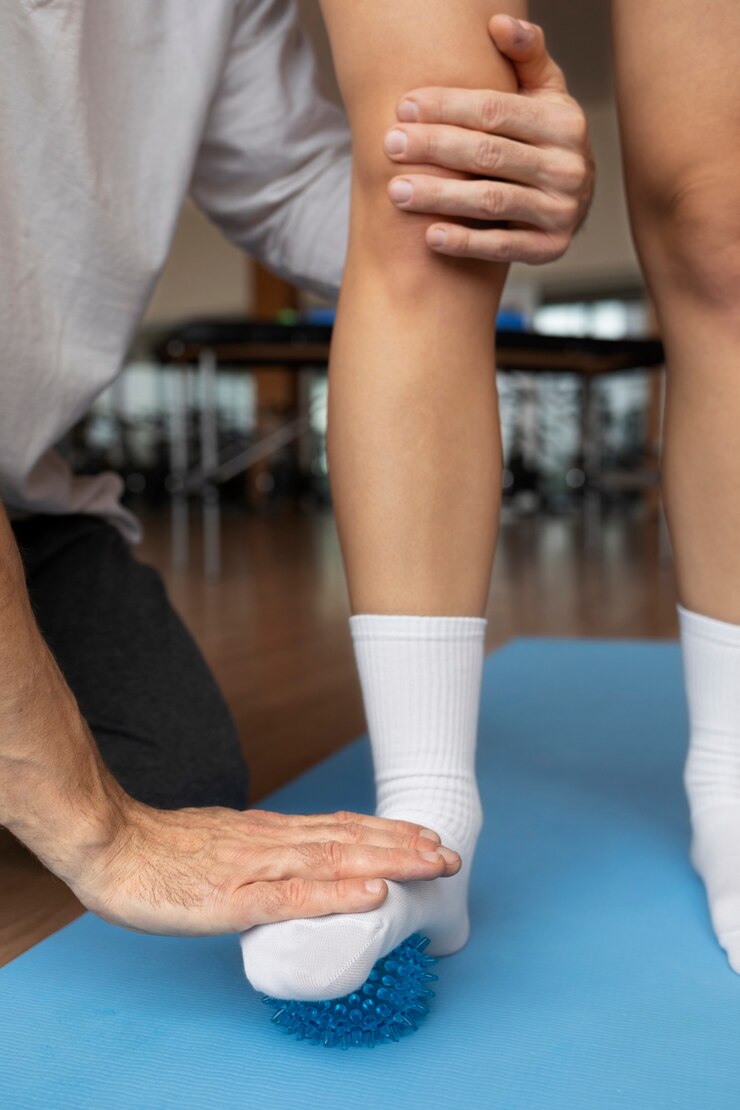Living with chronic foot and ankle conditions can significantly impact your mobility and quality of life. Conditions such as arthritis, plantar fasciitis, and tendonitis can cause persistent pain and limit daily activities. However, foot and ankle physical therapy offers a comprehensive solution to manage these issues effectively.
This blog explores how physical therapy benefits individuals dealing with chronic foot and ankle problems, providing relief, improving function, and promoting long-term health.
Understanding Chronic Foot and Ankle Conditions
Chronic conditions are long-lasting and often require ongoing management to prevent worsening. Common foot and ankle conditions include:
1. Arthritis
Arthritis causes inflammation in the joints, leading to stiffness, pain, and reduced mobility. It commonly affects the ankles and midfoot joints.
2. Plantar Fasciitis
This condition involves inflammation of the plantar fascia, a band of tissue connecting the heel bone to the toes. It often causes sharp pain in the heel, especially in the morning.
3. Tendonitis
Overuse or repetitive movements can lead to inflammation in the tendons, particularly in the Achilles tendon, causing pain and stiffness.
4. Peripheral Neuropathy
Often linked to diabetes, this condition causes nerve damage in the feet, resulting in numbness, tingling, or burning sensations.
5. Bunions and Hammertoes
Structural deformities can lead to chronic pain and difficulty wearing certain types of footwear.
How Foot and Ankle Physical Therapy Helps
Physical therapy provides tailored care for chronic conditions, focusing on:
1. Pain Management
Techniques such as manual therapy, ultrasound, and electrical stimulation reduce pain and inflammation, offering immediate relief.
2. Improved Joint Mobility
Therapists use stretching exercises and mobilization techniques to restore range of motion and prevent joint stiffness.
3. Strengthening Muscles
Weak muscles around the foot and ankle can exacerbate chronic conditions. Therapy targets these muscles to improve support and stability.
4. Enhanced Balance and Coordination
Conditions like arthritis or peripheral neuropathy can affect balance. Therapy includes exercises to improve coordination and prevent falls.
5. Education and Lifestyle Adjustments
Therapists educate patients on proper footwear, posture, and daily habits to minimize strain and prevent flare-ups.
Benefits of Physical Therapy for Chronic Conditions
1. Non-Invasive Treatment
Therapy eliminates the need for invasive procedures, focusing on natural healing and strengthening.
2. Personalized Care
Every patient receives a customized plan tailored to their specific condition, ensuring effective results.
3. Prevention of Condition Progression
By addressing the root causes, therapy helps slow the progression of chronic conditions and reduces the risk of complications.
4. Long-Term Pain Relief
Therapy offers lasting solutions by improving joint function, strengthening muscles, and addressing biomechanical issues.
5. Improved Mobility and Independence
Patients often regain the ability to perform daily activities without pain or limitations.
6. Enhanced Overall Quality of Life
Managing chronic conditions through therapy improves physical health, mental well-being, and overall life satisfaction.
Techniques Used in Physical Therapy
Physical therapy combines various techniques to address chronic conditions effectively:
1. Manual Therapy
Hands-on techniques like massage and joint mobilization relieve pain, reduce stiffness, and improve flexibility.
2. Strength and Stretching Exercises
Targeted exercises rebuild muscle strength, improve balance, and enhance joint flexibility.
3. Assistive Devices
Therapists may recommend orthotics, braces, or splints to provide additional support and alignment.
4. Gait Analysis and Training
For those with mobility issues, therapists assess walking patterns and provide corrective exercises to prevent strain.
5. Modalities for Pain Relief
Advanced tools like ultrasound, cold laser therapy, and electrical stimulation offer non-invasive pain relief and promote healing.
Lifestyle Tips for Chronic Foot and Ankle Conditions
In addition to foot and ankle physical therapy, adopting healthy lifestyle habits can help manage chronic conditions effectively:
- Wear Proper Footwear: Invest in supportive shoes with good arch support and cushioning.
- Stay Active: Low-impact activities like swimming or cycling help maintain strength without stressing the joints.
- Maintain a Healthy Weight: Reducing excess body weight alleviates pressure on the feet and ankles.
- Stretch Daily: Gentle stretches prevent stiffness and improve flexibility.
- Monitor Symptoms: Pay attention to changes in pain, swelling, or mobility and consult your therapist promptly.
FAQs
Q: Can physical therapy cure chronic foot and ankle conditions?
A: While therapy doesn’t cure chronic conditions, it significantly reduces symptoms and improves function, helping you lead a more active and pain-free life.
Q: How often should I attend physical therapy sessions?
A: The frequency depends on your condition and progress, but most patients start with 1–2 sessions per week.
Q: Is physical therapy effective for severe arthritis?
A: Yes, therapy helps manage pain and improve joint function even in advanced stages of arthritis.
Q: Can I perform therapy exercises at home?
A: Your therapist will likely recommend home exercises to reinforce progress between sessions.
Q: Is physical therapy safe for older adults?
A: Absolutely. Therapy is tailored to individual needs, making it safe and effective for all ages.
Conclusion
Dealing with chronic foot and ankle conditions can be challenging, but foot and ankle physical therapy offers a path to relief and improved mobility. Through personalized care, proven techniques, and a focus on long-term health, therapy empowers patients to manage their conditions effectively.
Don’t let chronic pain hold you back—consult a physical therapist to explore non-invasive solutions tailored to your needs. With the right approach, you can achieve greater independence, comfort, and overall well-being.
Read More
Breaking Barriers to Success: Why a Weight Loss Program in NY Works for Everyone



Pingback:Exploring Top Benefits of Body Sculpting in San Antonio: Why It's the Perfect Choice for You - Buddies Reach